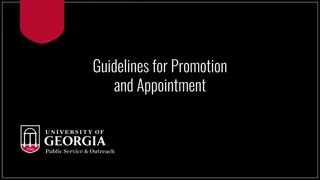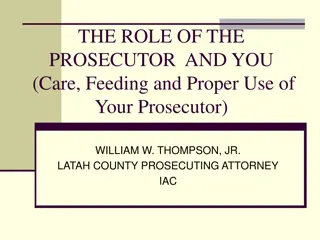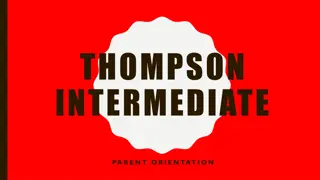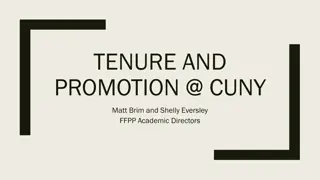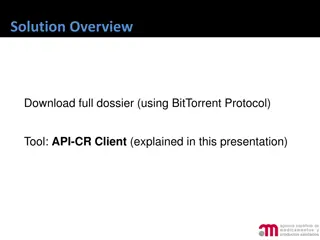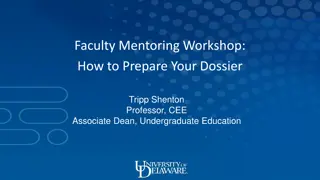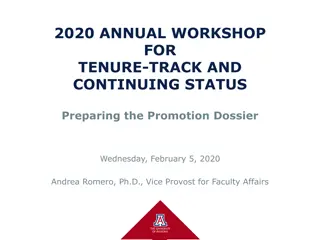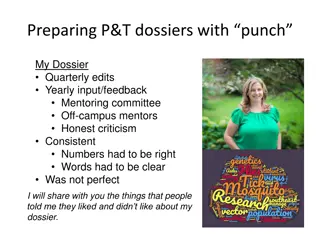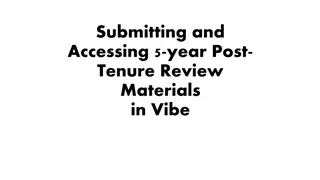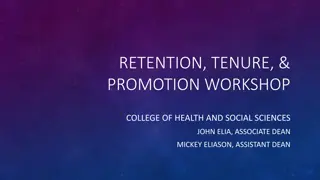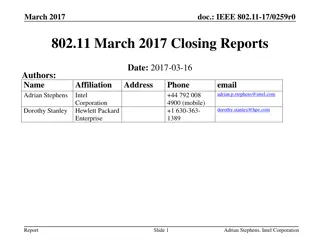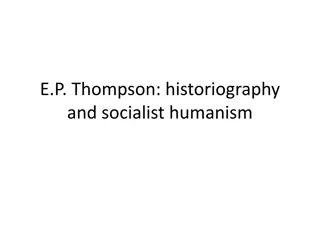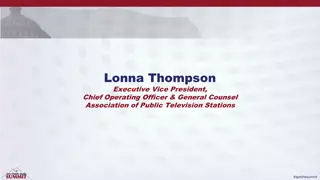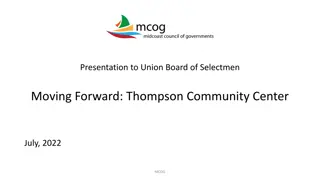
Mastering Dossier Development for Academic Success
Navigate the intricacies of dossier development with expert tips on organization, necessary steps, and common mistakes. Prepare effectively for reviews, keep key documents, and create a comprehensive dossier checklist.
Download Presentation

Please find below an Image/Link to download the presentation.
The content on the website is provided AS IS for your information and personal use only. It may not be sold, licensed, or shared on other websites without obtaining consent from the author. If you encounter any issues during the download, it is possible that the publisher has removed the file from their server.
You are allowed to download the files provided on this website for personal or commercial use, subject to the condition that they are used lawfully. All files are the property of their respective owners.
The content on the website is provided AS IS for your information and personal use only. It may not be sold, licensed, or shared on other websites without obtaining consent from the author.
E N D
Presentation Transcript
Objectives Identify necessary steps to prepare for dossier development. Explain the importance of effective organization of the dossier. Discuss items commonly required in the dossier. Identify common mistakes seen in submitted dossiers.
Preparing for your review Complete a detailed annual review report each year .outline all accomplishments in teaching, scholarship, service and related professional activity (if applicable). Meet annually with your chair to review your progress, needs for improvement, and to receive feedback from tenured faculty.
Preparing for your review Keep copies of all teaching evaluation summaries, syllabi, course materials, articles, presentation abstracts, letters from students, committee chairs, and the community which acknowledge your work. For reappointment, treat your dossier as a mini-P&T dossier. Review the school requirements for dossier preparation and documentation.
Organization is key Even the most productive faculty member may have a difficulty making their case without good organization. Have a clear table of contents. Use tabs or folders to separate content. Make sure your CV is up to date and is formatted correctly-education, professional experience, publications, grants, presentations etc.
Dossier Checklist Title page with year or years of evaluation. Letter requesting reappointment, tenure, or promotion. Make sure you state what years are being evaluated and when you were hired. Table of contents. CV. Letter of appointment.
Dossier Checklist Copy of elaborations (college, department). ARPA s. Letters each year from DPC, Chair, CPC, UCAP, Provost and President. 2-3 page overall summary of highlights and accomplishments in key elaboration areas. External review letters (if applicable).
Dossier Checklist Copy of elaborations (college, department), ARPA s. Letters each year from DPC, Chair, CPC, UCAP, Provost and President. 2-3 page summary of highlights and accomplishments in key elaboration areas. External review letters (if applicable). Detailed narrative for each application section-teaching, service, scholarship.
Teaching In this section, it is important to show the effectiveness of your teaching as well as ways you have attempted to improve your teaching. A teaching philosophy is recommended. Student evaluations with total means and averages may be useful.
Teaching Samples of syllabi, lecture materials and formative and summative assessments. Evidence in professional development (teaching workshops, peer observations, quality matters certification. Teaching awards, and curriculum development may also be listed.
Scholarship Scholarship can come in many forms. Usual examples include, publications, books, presentations both peer reviewed and invited. Documentation is important so possibly include article copies, links or even under review confirmation letters. Some areas may suggest showing a line of inquiry or documenting the quality of publication in terms of article citations and impact factor. Grant submissions and awards would also be submitted in this area.
Service There are many areas of service that can be documented- departmental, college, university, community, and professional. It is a good idea to have a balance of these. Examples of UT related service may include committees, accreditation of programs, and faculty senate.
Service Professional service may include serving as a journal editor, reviewing abstracts, planning conferences, serving on committees, and being an elected leader. Community service is a broad category that may include public consulting (non-paid), educational speaking, serving on boards or coalitions, and volunteering.
Common Mistakes Missing documents. Poorly organized. Mislabeling of content (service artifacts placed in scholarship category). Missing or poorly written narratives. Including non significant or redundent artifacts. Misrepresenting material. More is not always an indicator of quality.
Final Tips Plan for success and continuous meeting of elaborations. Develop short-term and long-term goals. Find a mentor and have them review your progress and dossier. Ask members of the DPC or CPC to give you early feedback. If you are struggling, find a mentor in that area. PROOF YOUR WORK. Breathe



